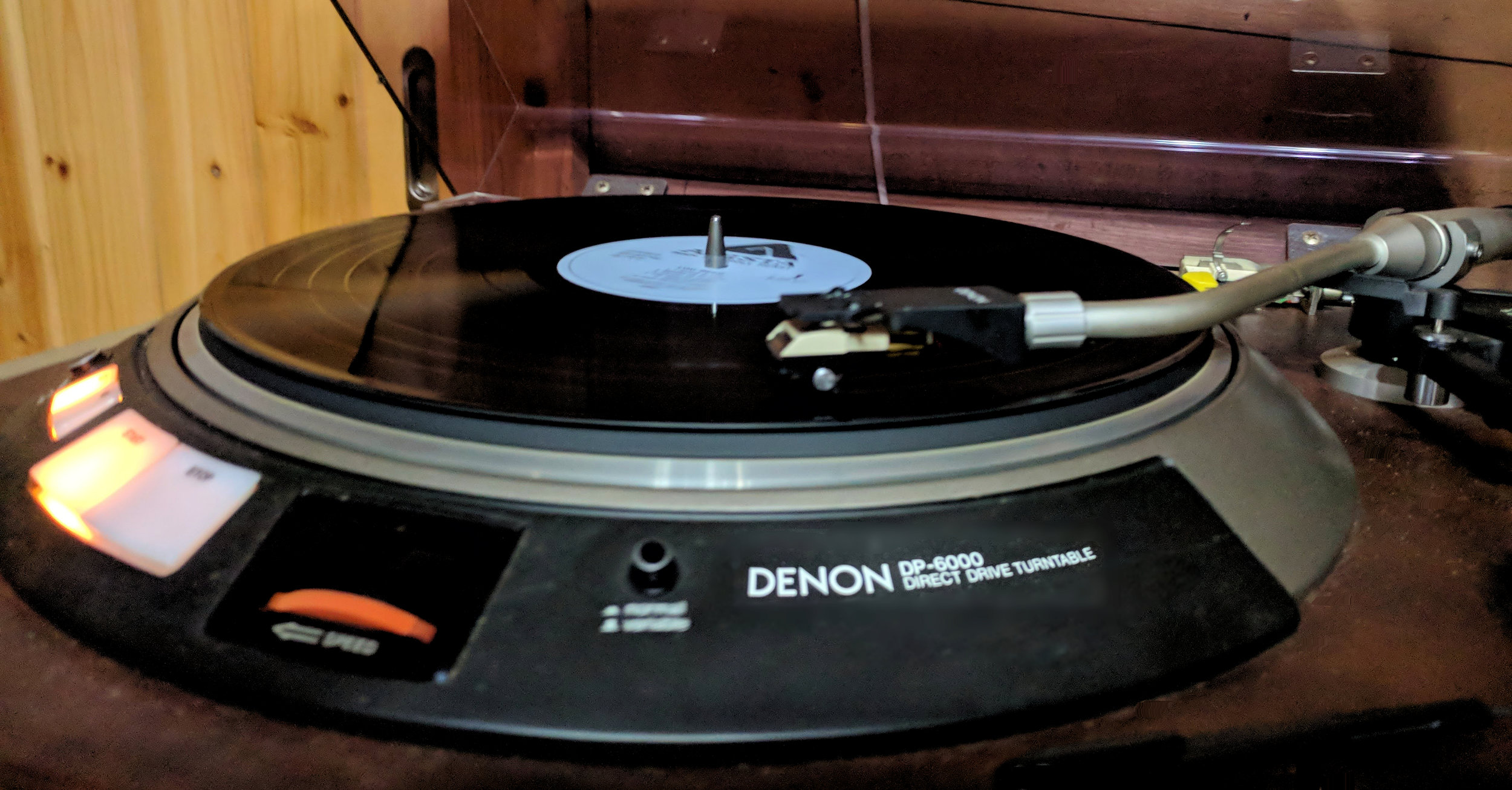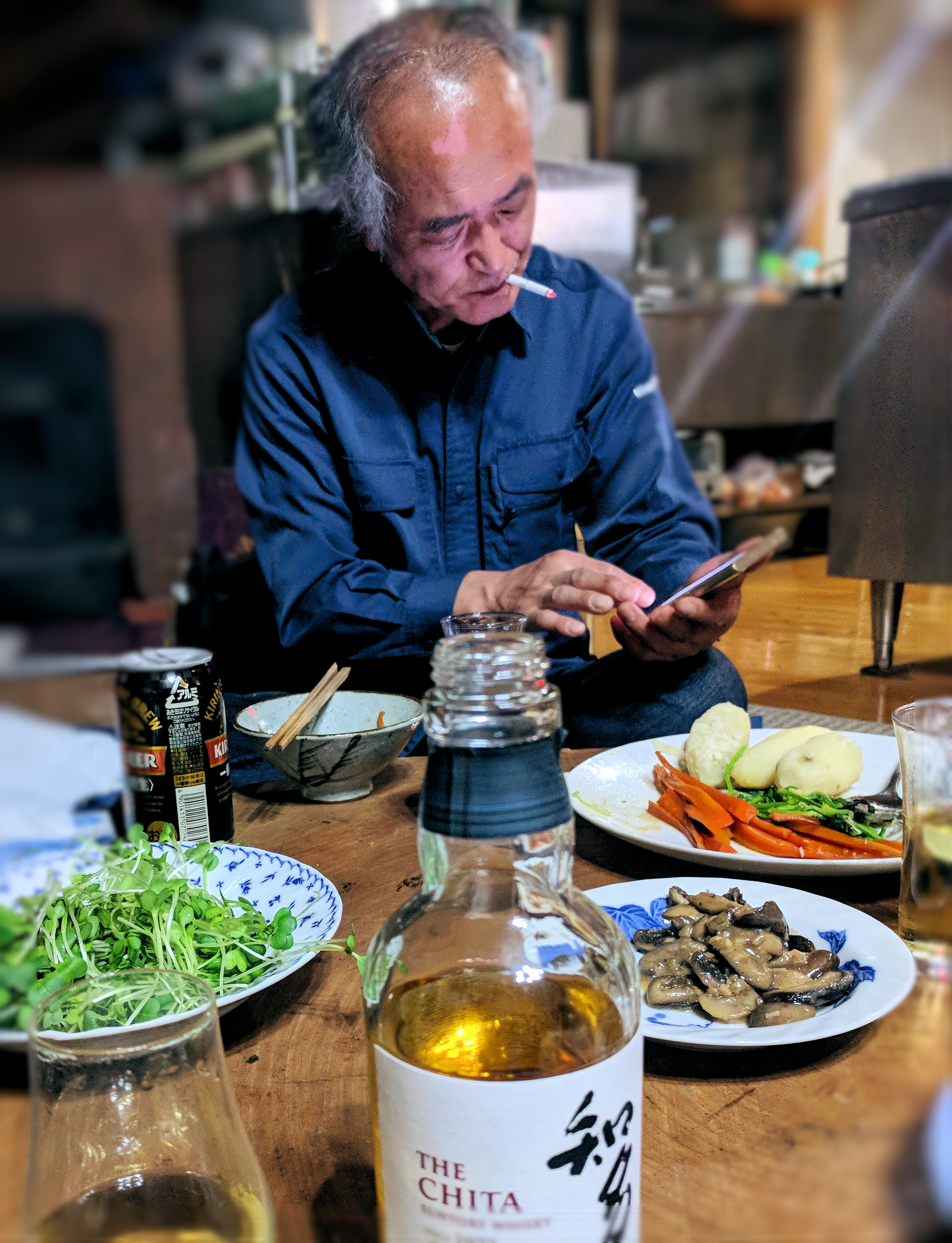"Winter is hell." Toshiharu nods toward the snow outside, now melting under the warm spring sun. He sighs and returns to polishing his 60’s Les Paul by the fire. “The snow gets so deep…” he says quietly, apparently now talking to the Gibson. The metronomic drip, drip, drip of melting snow is abruptly interrupted by the snap of his closing guitar case. He looks out at the snow again, drains his coffee cup, and commands: “We should climb the mountain.”
I had arrived late the previous evening; late, because of my cunning shortcut over the mountain top. A heavy snowfall had closed the pass but the resulting circuitous route was rewarded by the sight of bear cubs, scampering over snowdrifts. Night had long since fallen when I finally rapped on the door of Toshiharu’s cabin. Footsteps echoed from inside… The door flung open, light and warmth streamed out and there was Toshiharu-san (not mad at me at all), beaming and exclaiming “Yōkoso!” (Welcome).
Nestled in a tranquil mountain valley, betwixt Japan’s Niigata and Fukushima Prefectures, is Toshiharu's Hanaikada Guest House and Recording Studio. The surrounding mountains and ancient forests are spectacular, as is Toshiharu's home; a hand-made masterpiece of solid pine logs, hewn from the forest aside by Toshiharu himself.
He shoots me a withering glance as I accidentally step on the tatami while taking off my wet shoes. And so I have, once again, disgraced myself; not for the last time.
The wind was howling outside and snow buffeted the windows as I was ushered to a seat by the fire. Toshiharu had other guests that evening; some self-described “Salary-Men” from Tokyo. They had long since finished dinner but hurried to prepare something for me. Before I could preempt their inevitable first question by pronouncing “Watashi wa Australia jin desu” I was handed a beer and a plate of something oishī (delicious).
The “Salary Men” turned out to be a group of CEO’s escaping the pressure of Tokyo; in the wilderness, off-grid. My intention to retire early evaporated when Toshiharu opened the bottle of Beenleigh Rum I had brought him. After a ritual exchange of business cards, we shared the rum and stories until the small hours. So the following morning, when Toshiharu suggested “we should climb the mountain” I was not at my most energetic. Nevertheless, it was a beautiful day and not to be wasted. The snowstorm had passed during the night and although snow was still piled high outside, a warm sun shone from a clear sky.
As it turned out, my increasing girth was not to be threatened by strenuous exercise. When I emerged from the cabin with my hiking gear, backpack and supplies for the trek, Toshiharu suggested “perhaps it would be easier if we drive?”. The road did indeed go almost all the way to the mountain peak, leaving only a short climb. “Sugoi yo!” I exclaimed, overwhelmed by the spectacle of intersecting mountain ranges. “Now back to work, then you make dinner, something Australian” Toshiharu commanded. I surveyed the rugged, snow covered terrain and despaired at the prospect of finding a wallaby for dinner.
Unable to locate even a trace of marsupial, we stopped at a village on the way back to the cabin to buy supplies. We picked up another bottle of whisky too (just in case). I had seen elderly people picking a native plant on the roadside and found something similar at the market with which to make tempura. Later, I thought of those people; of how they are in harmony with and live off the land as generations before have done. And, as I thought of the radiation that fell from the skies here are few years ago, I was thankful for the cleansing snow-melts.
That afternoon was spent in the studio and attempting to repair random electronics, including Toshiharu’s radio, strangely unable to get good reception in a deep valley surrounded by kilometers of solid rock. His drone baffled us both with its Chinese instructions but eventually it sprang to life and provided excellent video of its impact and subsequent destruction on the cabin wall.
It was at this point I realised that no wall of the log cabin was either parallel or perpendicular to another. Toshiharu proudly confirmed this by showing me his blueprints for the building. The point was not to replicate a Batman-style villain’s lair but (together with the log walls) to provide the desired acoustics. Each room may be connected or isolated acoustically by means of sliding panels and the log walls. This finally explained the presence of Toshiharu’s drum kit in the kitchen, which was two sliding panels away from the studio.
Either my tempura met with Toshiharu’s approval, or he was too polite to say otherwise. “People here are so rude” he remonstrated over dinner. “Australians are much more polite”. I begged to differ, pointing out that Westerners this far off the beaten track would likely be on their best behavior and relatively sensitive to Japanese culture (ironically demonstrating the opposite by turning it into a competition). We agreed to differ and cracked open the Chita Single Grain. I’m not a great fan of grain whisky, but it was a quaffable change from single malt.
“Lee Ritenour!” Toshiharu requested as I thumbed through the R section of his records. I spontaneously winced at the prospect (reprising my first taste of the Chita), prompting him to continue “alright, you choose something”. I returned to the turntable with an armful of Lou Reed, Ramones and Rolling Stones, without moving on from R. Toshiharu nodded his assent and produced a copy of Professional Sound Equipment 1984. This was to aid our discussion on the studio gear, commencing with his beloved ¥2,500,000 Westlake Monitors, now built into the control room walls.
We had given the Westlake’s quite a workout that afternoon via Toshiharu’s Amcron amplifiers. The Westlake’s impressive performance was tempered by my thoughts of how much better they would sound driven by a Naquadria Lucien or two… I considered offering to bring one next time, then pondered lugging its 30KG bulk up the mountain, along with the usual gifts of Australian wine, beer, whisky and fluffy koalas. At that point Toshiharu flicked the page; an ad for my dear old Soundcraft desk appeared and a new discussion ensued.
I have noticed that many Japanese people, who poses an adequate grasp of English, will not speak it, as they are too polite to risk making a mess of the language. I, however, have no such compunction in butchering theirs. More confident Eigo speakers do engage, with fine English, while I muddle along in response with the Nihongo vocabulary of a poorly trained pet. Toshiharu’s English is almost as inadequate as my Japanese; yet we spoke and laughed for hours that night, both fluent in the language of Sound.
I woke late the following day. The sadness of leaving was mitigated by the anticipation of subsequent adventure; a drive through the mountains to Sendai, Shinkansen to Tokyo and the warm familiarity of Asakusa. I packed the car and came back inside to find Toshiharu in the kitchen, brewing up a much needed Kōhī. He put a palm to his forehead, searching for a word… “Hangover”, I submitted, mirroring the gesture and hoping he had missed yet another tatami incursion. He nodded and smiled. “Good friend” he says, offering a cup of coffee. “Watashi mo” I retort. “When will you be back home?” he asks. “In about four months” I reply. “But first, I have to go back to Australia for a while.”
William Crampton
Arigatōgozaimashita Toshiharu-san. じゃあまたね
















